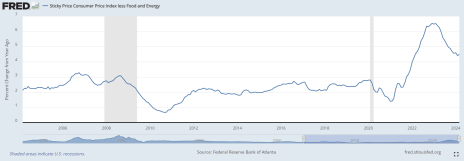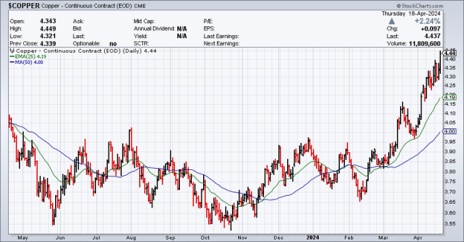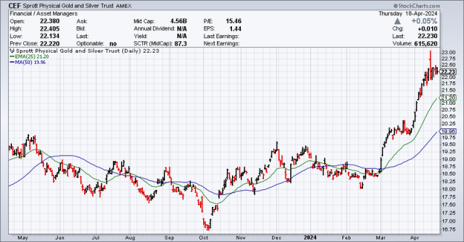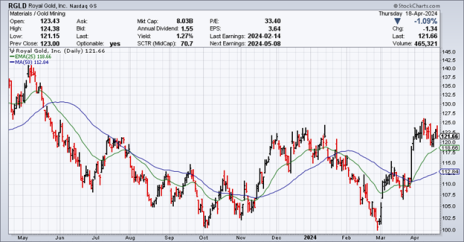After being largely ignored in the wake of the past year’s equity and crypto market boom, gold is commanding attention as an inflation hedge and, due to its recent strength, becoming something of a momentum play. Analysts are at odds when it comes to identifying all the reasons for gold’s stellar performance, but there’s little doubt that persistent inflation is a contributing factor.
Indeed, “sticky” consumer price increases are among the reasons investors give for buying gold as a hedge against future potential inflation. The Sticky Consumer Price Index measures price changes for goods and services that tend to be stickier (i.e., slower to decline) than, say, fuel prices. Examples of sticky prices include housing, medical costs and automotive expenses.




The sticky CPI chart below shows that while U.S. sticky prices have pulled back from the highs of last year, they’re still at multi-decade highs and are still near a 42-year high.
Moreover, the price of copper—an excellent barometer for inflationary pressure—is on the upswing again after a long period of quiescence. The famed market technician Tom McClellan recently noted concerning the red metal: “The latest posting for the consumer price index … caught many by surprise, but it reflects an upmove that already started in copper from its December 2023 low. The most recent jump … says that inflation isn’t yet done rising.”
McClellan noted that recent speculative activity among copper traders in China, plus the imposition on futures contracts for both gold and copper by the Shanghai Stock Exchange, may be a contributor to the red metal’s rally. But, he concluded, “For now, though, the message is that inflation is going to be rising for at least the next two months” based on copper’s historical tendency to predict broader price increases.
Yet another important consideration in the inflation discussion is that this is one of those rare times that both gold prices and Treasury yields are rising synchronously. This is a rare occurrence and, in fact, normally happens only when inflation pressures are pronounced.
For instance, during the runaway inflationary trend in the mid-to-late 1970s, bond yields and gold both rallied in unison while ignoring the typical inverse relationship between the two. (Since gold offers no yield, rising Treasury yields usually act as a headwind for gold prices as investors prefer the former to the latter.)
That consumers are turning to a gold inflation hedge can be seen in the fact that retail giant Costco is selling one-ounce, 24-karat gold bullion bars to its customers. Costco shoppers have been gobbling up those bars to the enormous sum of around $200 million per month!
That said, retail investor interest in gold isn’t the only place where demand for gold is coming from. It’s also coming from large institutions, including hedge funds, sovereign wealth funds (SWFs) and central banks. In fact, the World Gold Council expects record gold for 2024 with central banks accounting for an expected 500 tons in what some analysts are calling “break-neck speed” for central bank gold purchases (and nearly eclipsing a record last set in 1967).
With inflation likely to continue bolstering the future prospects for the shiny yellow metal, investors who want some exposure to a gold inflation hedge without the burden that comes with physical storage might consider owning an interest in a gold-backed ETF or established mining stock. To that end, here are two considerations for the gold-minded.
2 ETFs to Use as a Gold Inflation Hedge
The Sprott Physical Gold and Silver Trust (CEF) is a closed-end trust that invests in fully allocated physical gold and silver bullion in bar form.
In the words of the prospectus, it’s designed to “provide a secure, convenient and exchange-traded investment alternative for investors who want to hold physical gold and silver without the inconvenience that is typical of a direct investment in physical bullion.” The Sprott Gold/Silver Trust also provides liquid exposure to the bull markets in both metals and is one way to hedge against continued erosion of the dollar’s value.
Royal Gold (RGLD) is a streamer, which means it doesn’t engage in physically mining the metal but provides up-front payments to miners in exchange for the right to buy gold, silver, copper and other resources at a set price (or else receive a percentage of the metal), providing Royal with an advantage over traditional miners.
Royal’s strategy of adding growth by purchasing high-quality assets and focusing on liquidity and capital returns to shareholders has paid off in recent years, helping the company increase cash flow and dividends (it recently increased the dividend for the 23rd consecutive year, current yield: 1.3%). Management expects margins to remain strong this year despite higher costs for most producers, while Wall Street sees earnings jumping 20%-ish both this year and next.
Here at Cabot, we can help you navigate the market by selecting the most promising candidates in retail and many other sectors via Mike Cintolo’s weekly Top Ten Trader. Expert stock picking is paramount for navigating the market’s current challenges, which is why Top Ten Trader is ideal for participants who want to focus mainly on the strongest companies with the best short-to-intermediate-term growth potential.









